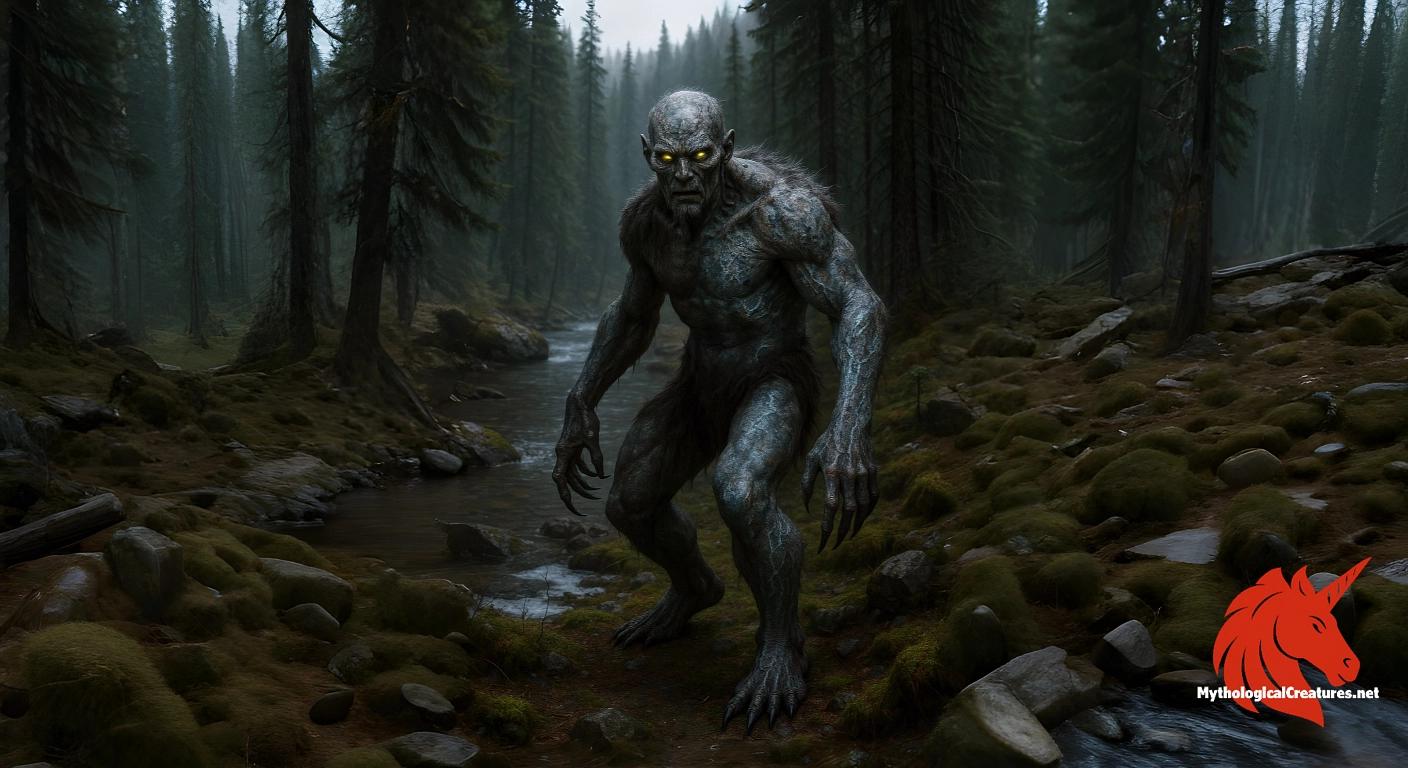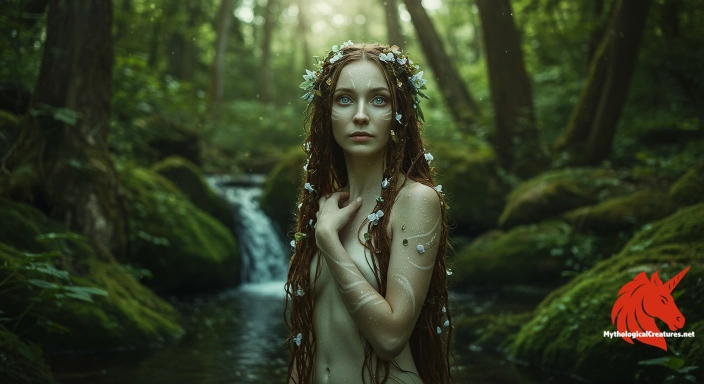Wechuge: The Wechuge is a cannibalistic, cursed creature from Athabaskan folklore, known for its menacing nature and enhanced physical strength.

Wechuge
Wechuge - Embodies the consequences of breaking cultural taboos and serves as a warning against becoming 'too strong' or prideful.
Origins & First Encounters
The wechuge emerges in Athabaskan myth as a formidable and enigmatic force, embodying both the raw power of nature and the curse of transgression. It is depicted as a man‐eating being whose very existence is bound to the breach of sacred taboos and the overreach of human strength. Within the Beaver (Dane-zaa) tradition, the creature is said to be a human overwhelmed by the potent spirit of an ancient giant animal. Its legend is interwoven with the fabric of northern oral traditions, reflecting a profound understanding of the balance between natural might and moral restraint. The narrative of the wechuge first took root in remote communities where every transgression risked awakening a dangerous, otherworldly force. Its transformation is portrayed not just as a physical mutation, but as a spiritual fall from grace that haunts both body and soul. The being represents the dire consequences of becoming “too strong” in a world where nature and morality must coexist in delicate harmony. Deep-seated fears about uncontrolled power and inner corruption resonate through every retelling of the myth. The tale continues to serve as both a stark warning and a captivating mystery, inviting reflection on the interplay between human ambition and the untamable forces of the wilderness. In this way, the wechuge remains a timeless symbol of the conflict between the civilized self and the wild, ungoverned spirit within.
Source Texts & Tale Variants
The primary sources for the wechuge legend lie in a rich tradition of oral storytelling passed down through generations of Athabaskan peoples. Rich narratives, as recounted by researchers such as Professor Robin Ridington, capture the creature’s multifaceted nature in the Peace River region. Diverse versions of the tale depict the wechuge as a cursed human transformed by an overwhelming inner force linked to ancient spirit animals. Some accounts emphasise detailed depictions of moral transgression—where a seemingly benign action triggers a catastrophic, supernatural metamorphosis. Local storytellers vividly recount incidents involving the breaking of taboos, such as the use of a camera flash or the consumption of meat tainted with fly eggs, each version underscoring the perils of defying natural law. Despite the absence of extensive written records, these oral testimonies offer a wealth of narrative detail that has shaped the creature’s image over time. Variants of the story also introduce unique elements, including descriptions of the wechuge’s icy composition and its cunning methods of enticing victims. Each regional narrative contributes to a tapestry of myth in which moral, physical, and supernatural dimensions intermingle. The layered versions of the myth invite us to consider how individual transgressions can escalate into a broader, intergenerational cautionary tale. Through its many iterations, the wechuge stands as a reminder of the delicate balance between human endeavour and nature’s formidable power.
Form & Powers
The wechuge is often depicted as a towering figure whose physical form teeters on the edge of humanity and beastliness. Many descriptions reveal a body coiled with superhuman strength and distorted by an unholy transformation that betrays its human origins. Its skin is said to bear an unnatural, sometimes icy sheen that evokes a sense of cold detachment and decay. Observers in the myth recount deep-set eyes that gleam with an eerie light, hinting at the unrestrained ferocity hidden within. The creature’s facial features frequently merge human expression with feral, animalistic traits, producing a visage that is as terrifying as it is fascinating. In some versions of the tale, the wechuge appears to be partially composed of ice—a physical manifestation of its chilling, cursed state. Limbs are described as elongated and sinewy, enabling swift, brutal movements that belie the creature’s enormous strength. The anatomical details vary across narrations, with some portraying the being as a hulking brute and others as a more spectral, almost insubstantial entity. Elements such as gnarled hands and distorted features combine to create an image that captures both the horror of physical mutation and the symbolic erosion of a once-human form. Through these varied descriptions, the physicality of the wechuge serves as a potent metaphor for the corruption of natural order.
Regional Faces
Regional variations of the wechuge myth highlight a fascinating interplay between local cultural practices and the universal themes of transgression and retribution. In the Peace River region, for example, the creature is deeply embedded in the social fabric of the Dane-zaa people, where specific taboos are intricately linked to its emergence. Some communities accentuate the element of ice in the wechuge’s makeup, aligning its mythos with the harsh, frosty environments typical of northern climes. Other variations place greater emphasis on the spiritual transformation that occurs when an individual becomes overwhelmed by the power of a giant spirit animal. Local storytellers adapt the legend to reflect their unique environmental conditions and societal norms, colouring the myth with regional dialects and symbols. In adjacent communities, the tale may interlace with other local spirits, lending the wechuge a multifaceted role as both a dire warning and a guardian of natural order. Even as the core narrative remains consistent, the nuances in its telling allow for slight differences in physical description and moral lesson. The diversity in these regional accounts illustrates how indigenous traditions mould myth to suit the landscape and cultural imperatives of their people. Each retelling reinforces a collective identity, while the variations serve as a reminder of the mutable nature of oral traditions. This regional adaptability has ensured that the myth retains its power and relevance across varying cultural landscapes.
Cultural Parallels
The legend of the wechuge invites comparison with a host of similar mythological figures that traverse diverse cultures. Its narrative shares striking similarities with the wendigo, another fearsome entity born from the violation of natural and social laws. While the wendigo is commonly associated with an insatiable hunger and the gradual decay of humanity, the wechuge uniquely entwines a transformation instigated by moral and spiritual excess. In both cases, these beings serve to warn against the dangers of overstepping natural limits and the perils of unbridled ambition. Comparative analysis reveals that, like many cautionary monsters in folklore, the wechuge functions as a mirror to society’s latent fears about losing control of one’s intrinsic self. Similar motifs appear in European and other indigenous mythologies where monstrous transformations are tied to hubris and the corruption of the soul. The duality of man and beast in both legends underlines a universal struggle between civilisation and raw, untamed nature. This cross-cultural dialogue between myths not only highlights shared human concerns but also accentuates the unique cultural inflections found within each tradition. The wechuge, with its ties to specific taboos and natural phenomena, stands apart even as it resonates with broader themes of supernatural retribution. Ultimately, these comparative perspectives enrich our understanding of how mythologies articulate the complex interplay of morality, power, and identity across different cultures.
Legacy & Modern Evolution
Over the centuries, the myth of the wechuge has evolved, reflecting shifts in societal values and the perennial human fascination with the supernatural. Originally a potent emblem within indigenous oral traditions, the creature’s story served as a direct commentary on the dangers of overreaching one’s natural bounds. As landscapes and lifestyles changed, so too did the interpretation of the wechuge myth, which came to symbolise the broader consequences of moral corruption and unchecked ambition. In more recent times, the figure has been reimagined in literature, art, and film, often appearing as a complex antagonist embodying both ancient curses and modern existential dread. Contemporary narratives tend to underscore the theme of transformation—linking the wechuge not only to the transgression of cultural taboos but also to broader issues such as environmental degradation and social disintegration. This evolving interpretation has ensured that the myth remains alive within both academic circles and popular culture, stimulating discussions about identity, power, and the loss of communal values. Modern artists and storytellers have embraced the wechuge as a metaphor for the dangers inherent in the pursuit of unrestrained power, mirroring today’s technological and ecological anxieties. Indigenous communities continue to draw on the myth as a reminder of the deep connections between cultural practices, respect for nature, and the maintenance of social order. The ongoing reinterpretation of the wechuge underscores its resilience as a symbol that bridges the ancient with the contemporary. In this way, the legacy of the wechuge endures, continually challenging each generation to confront the dark side of unchecked strength and the shadow of moral decay.
Interesting Fact
An intriguing aspect of Wechuge lore is that in some versions, it can only be defeated by being thrown into a campfire and left overnight, melting its icy form and symbolically purging its cursed strength.
Quick Creature Info
Origin:
Our Mythic Legendary Rating:

Habitat:
Supernatural Powers:
Physical Attributes:
Abilities:
Behavior:
Weaknesses:
Lore:
Related Creatures, Tales or Lore
References
Discover Another Mythical Legend You May Not Have Heard Of?
Uncover the mysteries of ancient folklore and expand your knowledge of legendary beings from cultures around the world.
Dare to Meet the Salmacis....
Mythical Disclaimer: The images and data on this site are derived from various historical and literary sources, but we have found that many myths often have multiple versions and interpretations across references, sometimes contradictory. As a result, these creature depictions are artistic interpretations—imaginative blends of folklore, legend, and a dash of AI guesswork. Because creature descriptions vary widely, our illustrations and accompanying information represent our best effort to honor mythology while bridging creative gaps. Enjoy these interpretations—just remember, we've done our best to respect the stories and validate available data, but in the realm of mythology, details often shift, imagination leads the way, and nothing is ever set in stone!
Curated by the Mythological Creatures Team (rev. May 2025)
